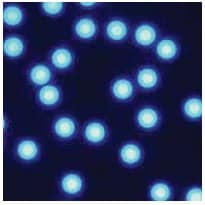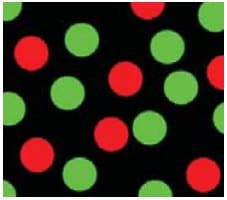Fluorescent Microparticles and Nanobeads
Microparticles have been found to have widespread applications in medicine, biochemistry, colloid chemistry, and aerosol research. Uses include chromatographic separation media, supports for immobilized enzymes, and spacers in liquid crystal displays. Fluorescently labeled microparticles are useful as standards in flow cytometry, confocal laser scanning microscopy, and with light scattering instruments. They also have been used in environmental science as tracers in flow measurements of gases and liquids, such as laser Doppler anemometry (LDA), particle dynamic analysis (PDA), and particle image velocimetry (PIV).
Melamine Resin Particles
We offer a new generation of monodisperse polymer microspheres (Figure 1) based on melamine resin (MF). Melamine resin microspheres are manufactured by acid-catalyzed hydrothermal polycondensation of methylol melamine in the temperature range of 70-100 °C without any surfactants. By adjusting the pH value, the concentration of methylol melamine, and the reaction temperature, monodisperse particles with a predictable size between 0.5-15 mm can be produced in a one-pot synthesis. With excellent physical and chemical properties, melamine resin particles offer many advantages over other conventional polymer particles.

Figure 1.Fluorescence microscopic image of 10 mm melamine resin particles labeled with 7-amino-4-methylcoumarin (reproduced with permission of Microparticles GmbH).
Physical and Chemical Properties of Melamine Resin Particles
- Density: 1.51 g/cm3
- Refractive Index: 1.68
- Excellent monodispersity (C.V. <3%) and highly uniform spherical shape
- Hydrophilic surface
- High crosslinking density
- High thermostability up to 300 °C
- Superior mechanical strength
- Stable and insoluble in acids and bases
- Extremely high stability in organic solvents, no swelling or shrinking upon contact with organic solvents
- Outstanding long-term stability in dispersions; no additives or stabilizers required
- Aqueous suspensions are stable to repeated freeze-thaw cycles
- Particles can be dried directly from their aqueous dispersions
- Free flowing powders of dried particles can be redispersed in any dispersing agent without agglomeration
Unmodified MF particles have a hydrophilic, charged surface due to the high density of polar triazine-amino and -imino groups. The surface functional groups (methylol groups, amino groups, etc.) allow covalent attachment of other ligands. For special applications, the MF particles can be modified by incorporation of other functionalities such as carboxyl groups. This increases possible surface derivatization such as chromophore or fluorophore labeling. Melamine resin microspheres are available as white particles or with internally incorporated fluorescent labels. Both particle types are available with either unmodified or carboxylated surfaces.
Fluorescently Labeled and Carboxylate-Modifi ed Melamine Microparticles
Fluorescent melamine resin microspheres can be prepared with variations in size, type of fluorochrome, and surface functional groups. Typical dyes used in MF fluorescent particles are:
- FITC, green fluorescence (λEx = 506 nm, λEm = 529 nm)
- Rhodamine B, orange fluorescence (λEx = 560 nm, λEm = 584 nm)
- Nile Blue A, red fluorescence (λEx = 636 nm, λEm = 686 nm).
Outstanding characteristics of fluorescent MF particles (Figure 2) are their narrow size distribution and an intense color and fluorescence. The homogeneously volume-stained particles have no leaching of the internally incorporated fluorochromes and they show high stability in organic solvents, comparable to white MF particles. Fluorescent MF beads are also available with carboxylate- modified surfaces containing a high density of functional groups (>0.1 mmole per gram of resin).

Figure 2.Fluorescence microscopy image of FITC-labeled MF particles (shown as green) and Rhodamine B-labeled MF particles (shown as red).
Fluorescent Nanobeads (Nanoparticles)
The understanding of nanoscale systems has advanced rapidly over the last few years, and these exciting scientific developments are being translated into a new generation of high technology products and processes. Nanotechnology has the potential to impact a wide range of applications, from chemicals to electronics, to sensors, to advanced materials. Nanoparticles have even been used as drug carriers for DNA.
One major aspect of nanotechnology is the development of fluorescent nanoparticles, which may have applications in optical data storage and the areas of biochemistry, bioanalytics, and medicine. Current fluorescent imaging methods are primarily based on dye markers, which have limited photostability and light emission per molecule. Nanoparticles overcome these limitations by offering more intense and stable fluorescent signals. Fluorescently labeled nanoparticles have been successfully used in a variety of immunoassays. Some of the limiting factors in latex agglutination assays can be avoided by using very small particles, which reduce the background absorbance and provide better colloidal stability.
Base Materials
Fluorescent nanobeads (nanoparticles) can be prepared from a variety of polymers, each providing certain advantages.
Polyacrylnitrile (PAN) nanoparticles are ideally suited for FRET applications. When labeled, they are highly fluorescent and extremely small (less than 30 nm in diameter). PAN has a low concentration of interfering substances and the nanoparticles are available with carboxylated or streptavidin modified surfaces. All particles are supplied as a 0.5% (w/w) buffered aqueous suspension (10 mM MES, pH 7).
PD is a novel polymer offering properties similar to polystyrene, but with much lower oxygen permeability, which results in a higher photostability for most dyes. Particle size is ~40 nm and the particle surface can be carboxylated or otherwise modified. All particles are supplied in a 0.5% (w/w) buffered aqueous suspension (10 mM MES, pH 7).
Custom Particles
Custom microparticles and nanobeads with specific modifications such as streptavidin are also available. Please inquire at your local office or with your sales representative for custom microparticles and nanobeads.
Materials
To continue reading please sign in or create an account.
Don't Have An Account?